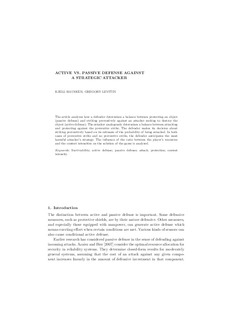| dc.contributor.author | Hausken, Kjell | |
| dc.contributor.author | Levitin, Gregory | |
| dc.date.accessioned | 2013-08-22T11:55:40Z | |
| dc.date.available | 2013-08-22T11:55:40Z | |
| dc.date.issued | 2011 | |
| dc.identifier.citation | Hausen, K. (2011) Active vs. passive defense against a strategic attacker. International Game Theory Review, Vol. 13(1), pp. 1-12 | no_NO |
| dc.identifier.uri | http://hdl.handle.net/11250/184303 | |
| dc.description | Active vs. Passive Defense against a Strategic Attacker, Kjell Hausken & Gregory Levitin, International Game Theory Review, Vol 13 and Issue No. 1, Copyright @ 2011, made available with permission from World Scientific Publishing Co. Pte. Ltd. | no_NO |
| dc.description.abstract | The article analyzes how a defender determines a balance between protecting an object (passive defense) and striking preventively against an attacker seeking to destroy the
object (active defense). The attacker analogously determines a balance between attacking
and protecting against the preventive strike. The defender makes its decision about
striking preventively based on its estimate of the probability of being attacked. In both
cases of preventive strike and no preventive strike, the defender anticipates the most
harmful attacker’s strategy. The influence of the ratio between the player’s resources
and the contest intensities on the solution of the game is analyzed. | no_NO |
| dc.language.iso | eng | no_NO |
| dc.publisher | World Scientific Publishing Co. Pte. Ltd. | no_NO |
| dc.subject | defense | no_NO |
| dc.subject | attack | no_NO |
| dc.subject | survivability | no_NO |
| dc.subject | protection | no_NO |
| dc.subject | contest intensity | no_NO |
| dc.subject | game theory | no_NO |
| dc.title | Active vs. passive defense against a strategic attacker | no_NO |
| dc.type | Journal article | no_NO |
| dc.type | Peer reviewed | no_NO |
| dc.subject.nsi | VDP::Social science: 200 | no_NO |
| dc.source.pagenumber | 1-12 | no_NO |
| dc.source.volume | 13 | no_NO |
| dc.source.journal | International Game Theory Review | no_NO |
| dc.source.issue | 1 | no_NO |
| dc.identifier.doi | http://dx.doi.org/10.1142/S0219198911002812 | |
